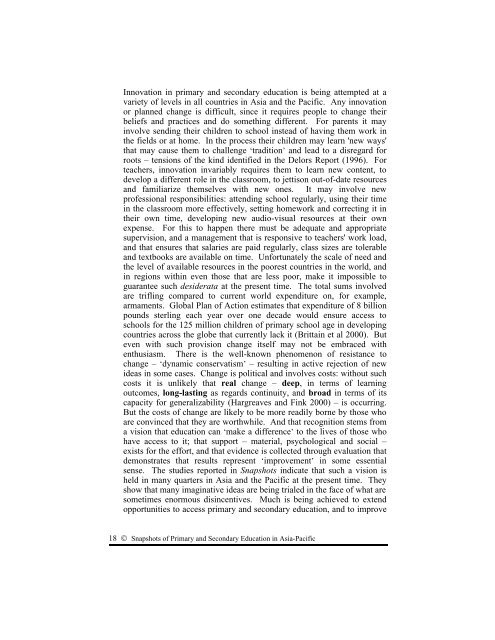Download PDF, 752KB - UNESCO Bangkok
Download PDF, 752KB - UNESCO Bangkok
Download PDF, 752KB - UNESCO Bangkok
Create successful ePaper yourself
Turn your PDF publications into a flip-book with our unique Google optimized e-Paper software.
Innovation in primary and secondary education is being attempted at avariety of levels in all countries in Asia and the Pacific. Any innovationor planned change is difficult, since it requires people to change theirbeliefs and practices and do something different. For parents it mayinvolve sending their children to school instead of having them work inthe fields or at home. In the process their children may learn 'new ways'that may cause them to challenge ‘tradition’ and lead to a disregard forroots – tensions of the kind identified in the Delors Report (1996). Forteachers, innovation invariably requires them to learn new content, todevelop a different role in the classroom, to jettison out-of-date resourcesand familiarize themselves with new ones. It may involve newprofessional responsibilities: attending school regularly, using their timein the classroom more effectively, setting homework and correcting it intheir own time, developing new audio-visual resources at their ownexpense. For this to happen there must be adequate and appropriatesupervision, and a management that is responsive to teachers' work load,and that ensures that salaries are paid regularly, class sizes are tolerableand textbooks are available on time. Unfortunately the scale of need andthe level of available resources in the poorest countries in the world, andin regions within even those that are less poor, make it impossible toguarantee such desiderata at the present time. The total sums involvedare trifling compared to current world expenditure on, for example,armaments. Global Plan of Action estimates that expenditure of 8 billionpounds sterling each year over one decade would ensure access toschools for the 125 million children of primary school age in developingcountries across the globe that currently lack it (Brittain et al 2000). Buteven with such provision change itself may not be embraced withenthusiasm. There is the well-known phenomenon of resistance tochange – ‘dynamic conservatism’ – resulting in active rejection of newideas in some cases. Change is political and involves costs: without suchcosts it is unlikely that real change – deep, in terms of learningoutcomes, long-lasting as regards continuity, and broad in terms of itscapacity for generalizability (Hargreaves and Fink 2000) – is occurring.But the costs of change are likely to be more readily borne by those whoare convinced that they are worthwhile. And that recognition stems froma vision that education can ‘make a difference’ to the lives of those whohave access to it; that support – material, psychological and social –exists for the effort, and that evidence is collected through evaluation thatdemonstrates that results represent ‘improvement’ in some essentialsense. The studies reported in Snapshots indicate that such a vision isheld in many quarters in Asia and the Pacific at the present time. Theyshow that many imaginative ideas are being trialed in the face of what aresometimes enormous disincentives. Much is being achieved to extendopportunities to access primary and secondary education, and to improve18 © Snapshots of Primary and Secondary Education in Asia-Pacific
















